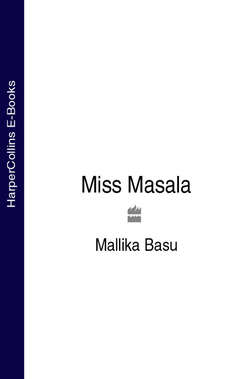Читать книгу Miss Masala - Mallika Basu - Страница 16
JALDI JALDI
ОглавлениеQUICK TRICKS FOR THE GODDESS IN YOU
Getting to grips with the recipes was one thing. Retrofitting them into my life was quite another.
In the early days, I made grand plans to further my cooking prowess. Never mind deadlines. I was going to powder my own garam masala. Marinate meat overnight. Cook raw chickpeas for hours as recommended by the latest cookery magazine. All the while, maintaining the karmic calm of a stoned Himalayan sadhu.
I soon realised that the truly inspirational cookery programme was presented by a celebrity with a crack team of experts. Invisible to the outside world, like Santa’s elves, they ran around her, shopping, chopping, cleaning and washing up, while others did her hair and mopped her brow.
I, on the other hand, had no one but my meagre self and a long list of urgent priorities. Work paid the bills. Friends were essential for fun. Men were high maintenance. Painting nails and updating my wardrobe were critical. Fashioning shortcrust dough into triangular-shaped samosas was not.
I decided that spending unnecessarily long toiling in the kitchen ranked close to ironing jeans and drinking Liebfraumilch. Daily slaving over a steaming pot simply wasn’t for me. The goddess in me needed shortcuts. Anything to make my life easier. This, believe it or not, was how Dada and my aunties operated too. I didn’t actually know anyone who made his or her own garam masala back home.
During my next food-shopping trip, I contemplated the complex equation of effort vs. reward. The answer seemed to be a pot of curry powder. This premixed ingredient is the mainstay of recipes in dog-eared women’s magazines at the dentist and the doctor’s. On the surface, it sounds like a godsend. A blend of essential whole spices such as cumin, coriander, chilli, cloves, black pepper, etc., ground into an all-purpose curry powder. Ready for whatever Indian dish you are planning to cook.
Easy, but so boring. I tried it with chicken. Then lamb. Next with vegetables. Everything tasted the same – of supermarket own-brand curry powder. This isn’t in the spirit of true Indian cooking. Half the fun is in the variation, adding a little bit of this and a little bit of that to end up with something truly unique. It was also far too reminiscent of the dried fruit and nut British homemade curries of the 70s. I cast the stuff aside and made once more for my haven of masala salvation – the Indian Spice Shop.
Here, I sought another vaguely familiar spice shortcut of the past. In my student years, Mother had taken to sending me presents via any willing London-bound relative. The parcels contained contact-lens solution (‘much cheaper in India’), boxes of sugary Indian mithai and cartons of recipe-specific spice blends, including ready-mixed meat masala, chicken masala and the optimistically named Kitchen King.
Alas, I hadn’t made the most of these gifts. My student brain cells had been reserved for the pursuit of an education in business, contemporary fashion and the exploration of illegal substances. But now I was a changed person. A clean and respectable, tax-paying, law-abiding goddess-in-the-making. I loaded the rickety basket with channa masala and kadai gosht masala and filled whatever space was left with cartons of Kitchen King.
In my apartment, the back-of-the-pack recipe for sautéed chickpeas instantly appealed. I stir-fried some onions and tomatoes; added 3 tablespoons of channa masala powder, and the tinned legumes became my new best friend. I sighed, ‘You complete me’ under my breath as I toasted wholemeal pitta bread. And then the doorbell rang.
It was a fellow would-be goddess in pink velour track pants – my neighbour from downstairs. Also third cousin, i.e. immediate family, and close friend. She wanted to borrow some serving dishes. ‘Are you cooking channa?’ she enquired as I threw the door open. ‘Yes. Doesn’t it smell great?’ I replied. I quickly ate a massive bowlful in front of the telly after she left and put away the leftovers to take for lunch at work. But as I walked through the corridor the next morning, nose twitching, I wondered what the neighbours thought of my kitchen wizardry.
It wasn’t just the corridor of our porter-guarded tower block that had been overtaken by the potent whiff of the spice blend. It had infiltrated my two tiny bedrooms, the inbuilt closets, my jewellery chest and every millimetre of upholstery. I frantically aired the flat, opening windows wide and lighting scented candles, but the smell of channa masala lingered on. Three days later when my neighbour came over to return the dishes and chat, I could smell the stuff emanating through the pores of the battered blue Ikea sofa.
The first lesson here was that chickpeas are the ultimate Indian fast food. The second and more important lesson was that ready-made spice blends do not always the best shortcuts make. The search for culinary tricks continued well into the next year of my big cooking adventure. And this is what I concluded: spices smell, so plan Indian cooking carefully.
Curry hair is never going to be the height of style. Every time I rushed out to party after a spot of cooking, I might as well have been balancing a pot of saag gosht on my head. Too self-conscious to show off my dance moves, I’d stand in a corner and drink myself silly instead. My dinner-party guests were subjected to it, too. No one ever thanked me for dry-cleaning bills for coats smelling of the jeera aloo I had served earlier.
The truth is that Indian spices smell pretty strong. I couldn’t avoid using them, so I just got smarter about managing them. It was a bit like smoking in my teenage years. Knowing my parents might catch me lighting up in the house didn’t make me stop – just encouraged me to stock up on air freshener and chewing gum.
